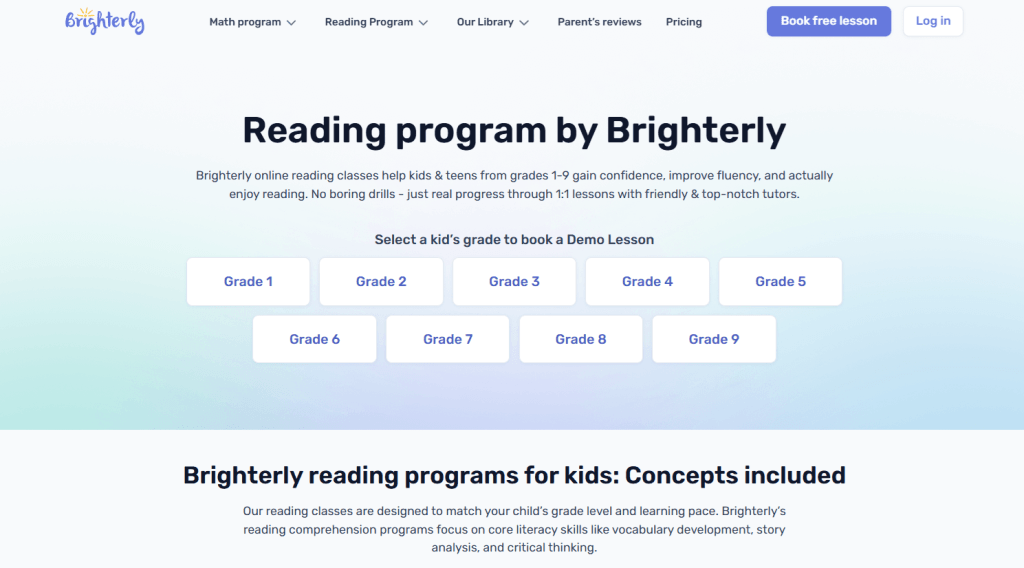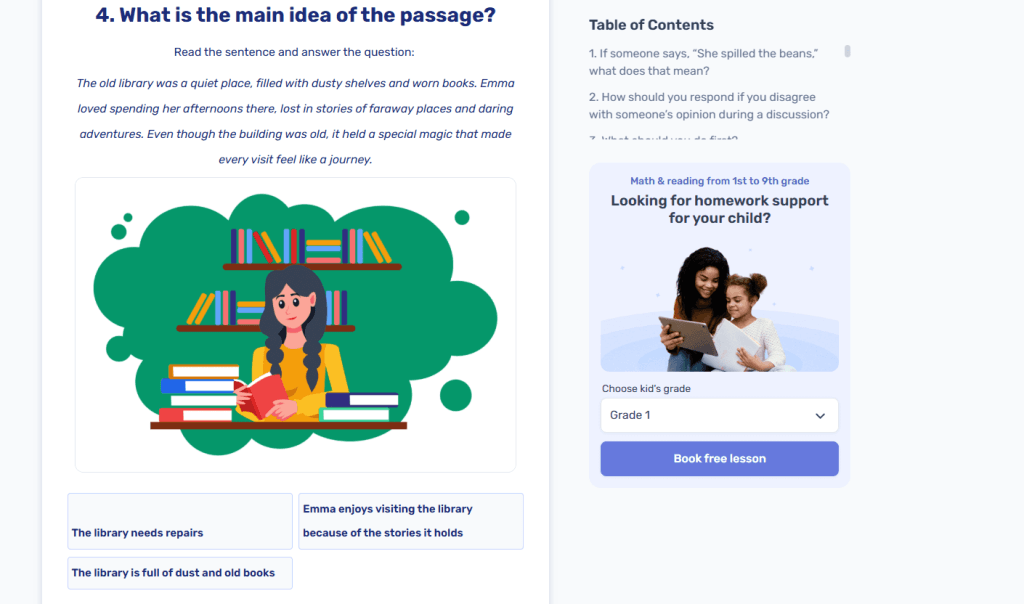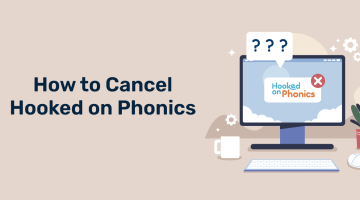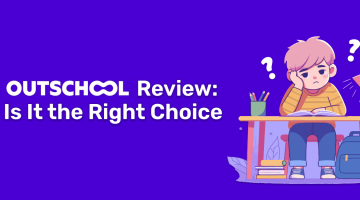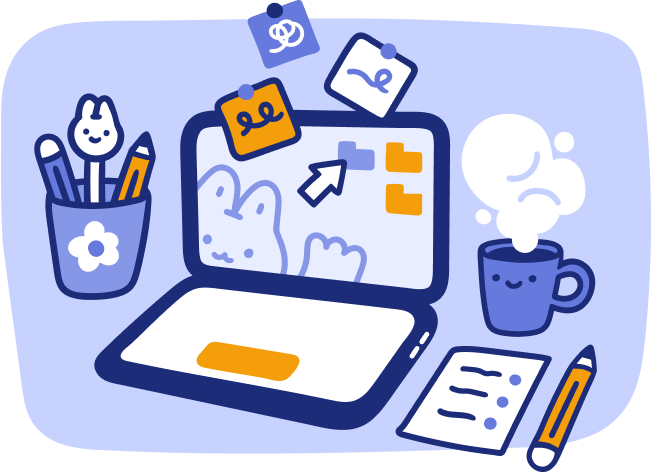The Best Reading Program for Dyslexia 2025
reviewed by Marvi M. Andres
Updated on November 14, 2025
As an elementary ELA teacher who has coached many families through dyslexia, I’ve learned that the best reading program for dyslexia is not a single brand but a way of teaching: explicit, systematic, cumulative, and human-guided.
In this guide, I’ll explain what that looks like in practice, how to evaluate online dyslexia reading programs, and where the Brighterly approach fits. Check out all the info!
Key points
- Solid research agrees: structured, explicit intervention is the surest path to better decoding and spelling for struggling readers.
- Brighterly is one of the best dyslexia reading programs, which combines a personalized approach with 1:1 lessons and gamified tasks.
- Some other reading programs for dyslexia that truly help children build their literacy include Orton-Gillingham Academy, Barton System, Wilson System, and Lindamood-Bell Program.
What is the best reading program for dyslexia?
The best reading program for dyslexia is the one that explicitly explains how written English works, presenting it step by step with guided practice and review. This order brings calm to what can otherwise feel like chaos.
Note: The article Dyslexia and Reading delves deeper into why such methods work best for dyslexic minds.
Effective teaching starts small, with sounds inside words. First, phonemic awareness (hearing and manipulating sounds), then systematic phonics (mapping sounds to letters and patterns), and extends to word structure (prefixes, roots, suffixes), vocabulary, and comprehension. It uses decodable texts that match today’s skill and brief reading tests to confirm mastery before moving on.
When families ask me, “What is the most successful reading program for dyslexia?” I answer: it’s the one that delivers those features with fidelity, and keeps the learning cycle going week after week.
Components of the best reading program for dyslexia
An effective dyslexia reading program includes the following integrated components: phonemic awareness, phonics & orthographic mapping, relation between encoding and decoding, fluency development, vocabulary building, comprehension strategies, and progress monitoring.
Now, let’s explore each one in more detail:
- Phonemic awareness. Daily oral blending, segmenting, and substitution exercises sharpen the “sound side” of reading.
- Systematic phonics and orthographic mapping. Letter-sound patterns are taught in a researched order (for example, short vowels → digraphs → blends → vowel teams → r-controlled) and are stored in memory through reading and spelling.
- Encoding (spelling) mirrors decoding. Every sound-symbol pattern practiced in reading appears in dictation and word-building, so spelling reinforces the same learning.
- Fluency. Repeated reading of controlled texts is a good reading help for dyslexia. It first improves accuracy, then rate and expression.
- Vocabulary and morphology. Highly used words and meaningful parts (prefixes, roots, suffixes) help students unlock longer words and academic language.
- Comprehension strategies and background knowledge. Sentence combining, knowledge-building, and text-structure awareness ensure that decoding growth turns into understanding.
- Progress monitoring. Brief, regular checks verify mastery and inform the next week’s plan.
Note: These structured principles also help non-dyslexic students. If that’s the case, the article Reading Programs for Struggling Readers will come in handy, offering a list of the best resources to help learners.
Families often compare options by browsing forum threads, “best reading program for dyslexia Reddit”. Those conversations show how many families are looking for practical, proven help.

But I encourage you to go beyond forum threads and look for the distinct features. Below are five widely used programs parents ask me about, along with how I frame them as a teacher.
5 best dyslexia reading programs
- Brighterly
- Orton-Gillingham Online Academy
- Barton Reading & Spelling System
- Wilson Language Training
- Lindamood-Bell Reading Programs
Brighterly reading program
Best for: Everyone
On the Brighterly math and reading platform, the core elements of a program for dyslexic learners are combined into a weekly rhythm that families can sustain. The learning here begins with short diagnostics aimed to pinpoint the exact patterns your child needs.
Then, during live sessions, reading tutors explicitly integrate oral phoneme warm-ups, new pattern instruction with cumulative review, controlled decodable reading, short dictation, and a brief fluency graphing moment.
This is what the Brighterly reading program looks like in action: structured, supportive reading help for dyslexia, designed for steady wins. Let’s explore some of its core features in more detail.
Key benefits of Brighterly
Personalized, data-driven lessons
Every child starts with a short skills check that identifies their exact reading needs: no guessing, no one-size-fits-all curriculum. Lessons are then adapted to match those results, ensuring every session targets what matters most. As progress is tracked, parents receive updates showing how decoding, fluency, and comprehension skills are improving week by week.
Live human connection that builds confidence
At Brighterly, instruction happens in real time. They are provided by caring, certified reading tutors who ensure personalized reading help for dyslexia. Children get patient feedback, encouragement, and structure during each lesson. This human element transforms frustration into motivation: kids begin to trust themselves as readers.
Consistent practice with free learning tools
Looking for dyslexia reading programs for free? While not entirely charge-free, Brighterly has lots of resources you can use for your home practice without paying a dime:
- Printable reading worksheets and easy-to-use decodable texts that match what’s taught in lessons.
- Reading tests are aimed at checking skill growth and monitoring fluency.
In addition to all these benefits, Brighterly keeps expert reading support within every family’s reach. The services are offered at an affordable price, starting at just $17.3 (when booking 3+ weekly lessons), making a structured, research-backed dyslexia reading curriculum accessible without financial stress.
Orton-Gillingham Online Academy
Best for: Children who need a calm, structured reading path that builds from simple sounds to complex patterns.
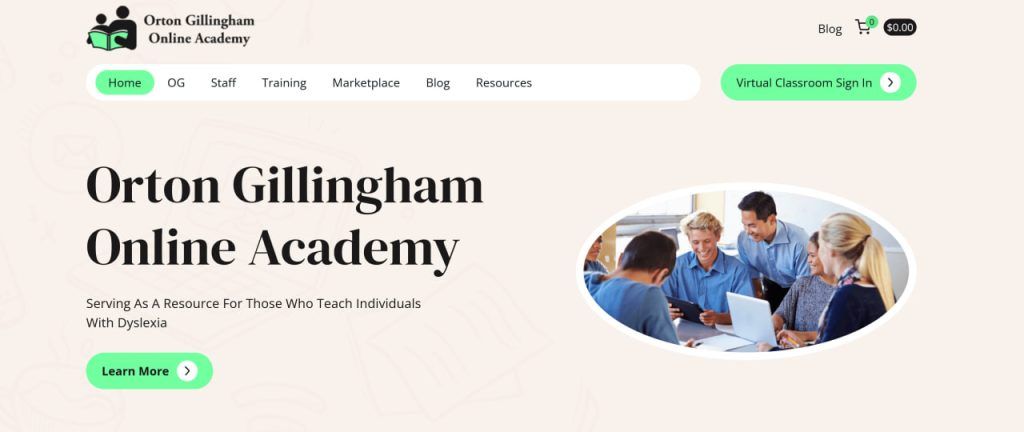
Orton-Gillingham (OG) has adopted a structured, multisensory approach that also underpins many other reading programs for dyslexia. The Online Academy provides training and materials aligned to explicit, sequential instruction.
In my experience, its strength lies in the predictable routine: phoneme work, direct teaching of patterns, cumulative review, decodable reading, and dictation. But note that not all OG programs are equally effective: results depend on how carefully they’re taught. The strongest progress happens when instruction is explicit, step-by-step, and continuously reinforced.
Barton System
Best for: Families seeking a clear, at-home program with strong support.
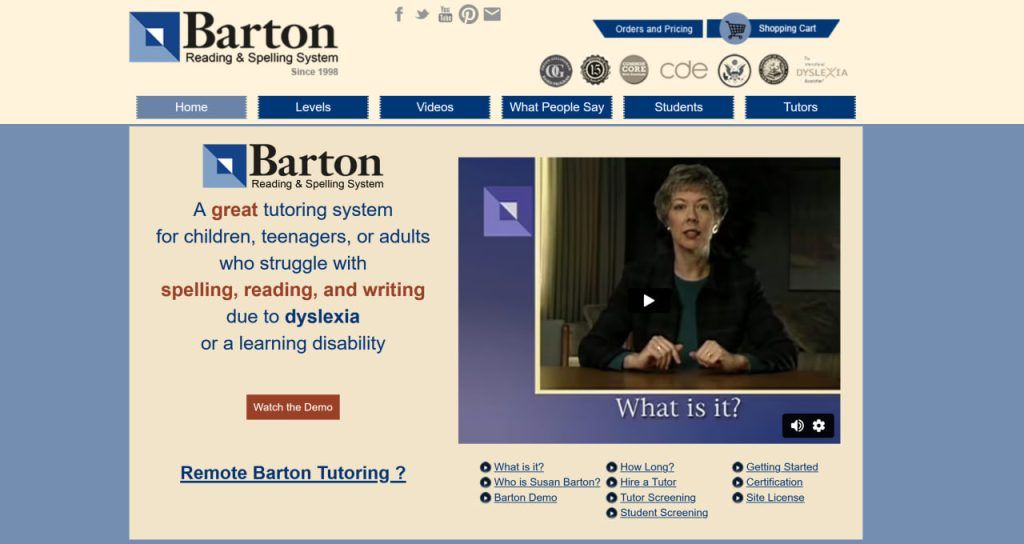
Barton is a one-to-one, scripted dyslexia reading program designed to be student & parent-friendly. I’ve coached families who appreciated Barton’s clear screening tools and the way each lesson spirals old skills before adding new ones. The cost and time commitment can be significant, yet for some students, the clarity and pace feel just right. That’s because encoding here is emphasized alongside decoding, which accelerates understanding.
Wilson Language Training
Best for: Students who know basic phonics but struggle with fluency or longer words.

Wilson offers a well-documented scope and sequence with strong encoding routines. Many parents choose reading programs for dyslexic students of this kind because their lessons are systematic, data-driven, and practical.
The Wilson Language Training uses a structured, multisensory approach rooted in phonics and spelling instruction. Its lessons combine sound-symbol activities, controlled reading, and direct word study to reinforce each new skill. This clear, consistent method supports learners who benefit from step-by-step practice and repetition.
Lindamood-Bell Program
Best for: Learners who need intensive help with phonological processing or comprehension.

Lindamood-Bell includes reading programs for dyslexia, like LiPS® (phoneme awareness) and Visualizing & Verbalizing® (comprehension/imagery). Their centers typically offer intensive schedules.
I’ve seen these programs help children who require heavy sensory scaffolding to establish or refine phonemic awareness, as well as those who need explicit imagery work to boost comprehension.
Note: Every effective reading program rests on three pillars: clear sound awareness, structured phonics, and continuous practice. When these align, even long-standing reading and spelling issues begin to improve.
Evidence-based reading programs for dyslexia
Evidence-based reading programs for dyslexia are structured teaching approaches proven through research to help students master reading step by step.
These programs include:
- Explicit instruction. Every concept is taught directly, not left to inference.
- Systematic sequencing. Skills are introduced in a logical, cumulative order.
- Decodable texts. Reading materials align with what’s just been taught.
- Integrated spelling. Decoding and encoding are practiced together.
- Ongoing progress checks. Frequent, short assessments guide instruction.
- Cumulative review. Previously learned skills are constantly revisited to build fluency.
Students with specific learning disabilities benefit most from a method that teaches sounds and decoding step by step. The IES practice guide outlines these proven steps for grades K–3 and beyond and remains one of the most reliable, evidence-based resources teachers can turn to.
Curriculum map adopted by the best online reading programs for dyslexia
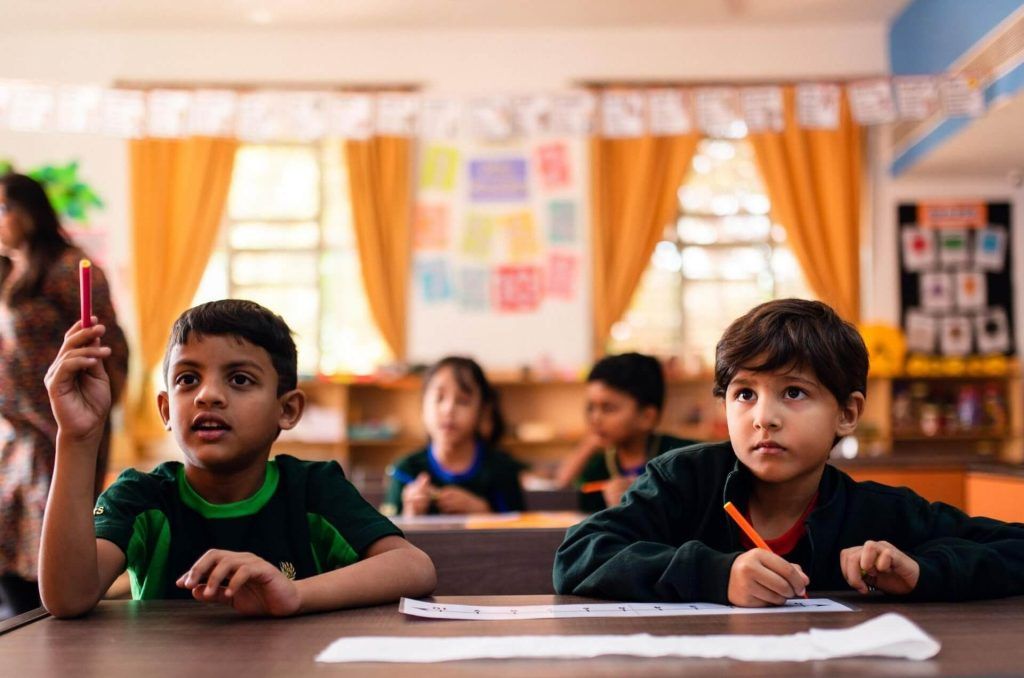
Let’s imagine how a full year of growth for dyslexic readers can unfold. The pacing described aligns with a reading curriculum for dyslexia and helps families see how skills build from speech sounds to connected text over time.
Phonemic foundations (Weeks 1–6)
For the first six weeks, students practice oral blending and segmenting every day. This will help them clearly hear and manipulate sounds in words, which are essential prerequisites to reading.
Teachers introduce consonants and short vowels in a carefully chosen order. They will also pair each new pattern with decodable texts so children read only what they have been taught.
Dictation is introduced from day one. It gives kids the opportunity to convert sounds into letters in writing, which reinforces the patterns they are learning to decode.
Digraphs and blends (Weeks 7–14)
During weeks 7–14, the teaching is focused on the commonly used digraphs (ie, sh, ch, th, wh, ck) and consonant blends within closed syllables. The curriculum now includes simple words with two or more syllables. This is great practice for students to consciously move from one part of the word to the next, reducing the reliance on pure estimation.
To build reading stamina, we start with timed, encouraging fluency tests, focusing on getting the words right before concentrating on establishing a smooth pace.
Vowel teams and r-controlled (Weeks 15–24)
From weeks fifteen to twenty-four of the dyslexia reading curriculum, lessons focus on long-vowel teams like ai/ay, ee/ea, oa/ow, and igh, as well as r-controlled vowels such as ar, er, ir, or, and ur. Morphology is also introduced by introducing high-utility prefixes and suffixes to help kids decipher longer words and identify meaningful parts of text (across science and social studies).
Complex patterns and morphology (Weeks 25–36)
In the last quarter of the year, children will learn about complex patterns such as soft c and g, frequently used Greek and Latin roots, and common syllable-division strategies for multi-syllable words. Word forming takes a higher prominence as we thread roots and affixes to content-area vocabulary, while also using explicit comprehension strategies to grade-level passages in science and history. At this point, students are reading and writing with greater control and can explain how familiar patterns assist them in determining unknown words.
To sum up, this year-long plan supports a dyslexia reading curriculum that combines phonics, morphology, and comprehension, all while building accuracy, fluency, and confidence over time.
Sample mini-lesson
Target: the “ai/ay” vowel team
Warm-up (2 minutes). We begin with quick oral phoneme drills to wake up the “sound side” of reading; for example, I say “/s/ /t/ /r/,” and the child blends the sounds and says “str.” This primes the brain to notice each sound before we add letters.
Teach (10 minutes). When using letter tiles, I explicitly demonstrate the sounds of “ai” and “ay” for the long /ā/ sound before the child constructs and reads words with either spelling pattern. We blend the sounds, read the words aloud, and then write the words in order for decoding and spelling to support each other.
Read (10 minutes). Next, we read a short decodable story that is packed with the target patterns: words like sail, grain, play, and spray. Because every word aligns with what has been taught, the kid experiences genuine success and practices accurate word reading in connected text. Such exercise is a powerful reading help for dyslexia.
Dictation (3 minutes). I dictate a few words and a simple sentence (such as “rain,” “playful,” and “I will spray the plants”), so the student practices converting sounds to letters and applies capitalization and punctuation in context.
Fluency (2 minutes). We are wrapping up the reading piece with a 60 reread, charting how many words were read correctly to celebrate improvement. The end goal is not to read fast simply for speed, but to support the reader in reading fluently and accurately until the reading naturally speeds up.
Wrap (3 minutes). To preview tomorrow’s learning, I add a brief morphemic teaser (for example, play + ful → playful) and connect it to words we just read. This keeps curiosity high and helps the child see how word parts carry meaning across texts.
This step-by-step process is similar to the instructional sequences that appear in most strong reading programs for students with dyslexia: clear instruction, controlled practice, and then cumulative review.
How to choose your variant out of the best online reading programs for dyslexia?
This checklist will help you compare the best dyslexia reading programs and pick what fits your child and schedule:
- It should include a clear scope where each lesson revisits prior skills.
- Decodable texts they use match the exact pattern taught today.
- Morphology is integrated only once basic phonics is in place.
- Fluency is based on accuracy first, then rate and expression.
- They provide visible progress data through frequent, brief checks and growth graphs.
- The programs fit the session length, tutoring frequency, and home practice, convenient for your family.
Note: You can explore additional learning options beyond dyslexia-specific tools by reviewing the article Best Reading Program for Kids.
But if you prioritize a human-guided option that ticks each box, the Brighterly reading program blends live coaching with structured practice materials so kids can keep winning academically.
Conclusion
Obviously, when it comes to teaching kids with dyslexia, there is no single “magic” brand. However, there is a clear recipe for success. Choose the best reading curriculum for dyslexia that is explicit, systematic, multisensory, and cumulative. Whether you lean toward OG-based options, Barton, Wilson, or Lindamood-Bell, look for those features and pair them with human coaching.
But if you want an encouraging, research-aligned start, the Brighterly math and reading platform was designed exactly for families like yours. When you are ready, book free reading lesson, and together with tutors, you’ll map out the next small, winnable steps.


